Case studies of some top-notch no-tillers (there are many).
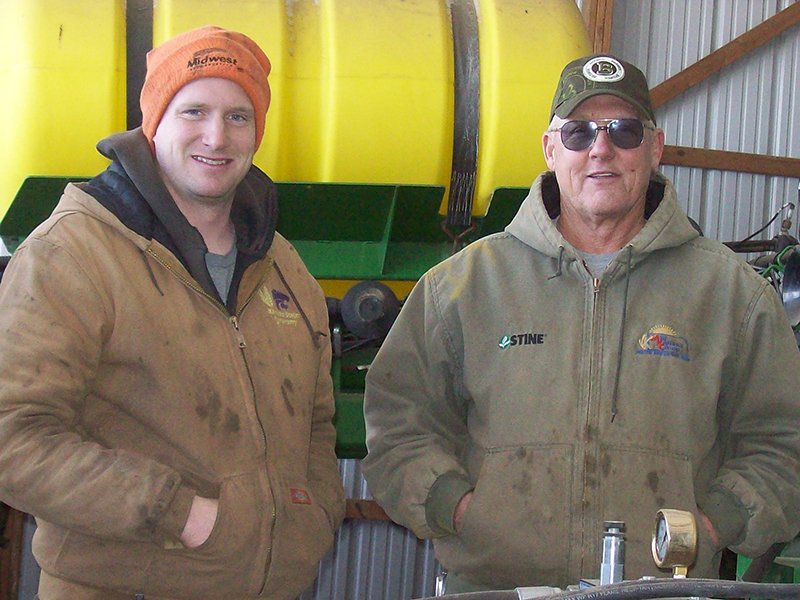
Whereas some successful no-tillers use their enhanced profitability and efficiency to double, triple or quadruple the size of their farms, Lewis Unruh has taken a different tack of paying off debt from buying land, upgrading antiquated and/or undersized machinery, and making way for another generation to earn a living on their farm—his son, Jason, returned to the farm a few years ago. They’re expanding some, also, and do a bit of custom work too.
Unruhs’ rotations have evolved a lot (I’ve had something to do with this, as I’ve been Lewis’ agronomist and field scout for 21 yrs). Where once they did a fair amount of second year corn, they gradually abandoned that practice due to erosion issues. Corn in their climate just doesn’t get tall enough to control erosion, especially not with how fast mulch decomposes in an area with 32 inches of precipitation per year, on average, and not freezing up during the winter (January temps average right around 32F for a historical average but seem to be getting milder).
Unruhs now routinely do cover-crop rye after the corn to prepare for soybeans the next year. They fertilize the rye to get a moderate amount of growth, and always let it go until heading to get the straw to last as long as possible (it lignifies as it gets closer to maturity—i.e., becomes more resistant to decomposition due to compounds called lignins). Cereal rye is drilled at a one bu/a (56#/a) rate (less if it’s unusually early), and gets around 130# of AMS product to help it make something of itself—if they don’t fertilize it, the rye will be stunted and might even winterkill partly on their thin soils, which is to say the majority of their acres. (If the preceding corn was droughted, they might not fertilize the rye at all.) Unruh’s try to manage the rye, so they get the right amount of biomass and tillering from the rye—enough to control erosion and suppress weeds, but not so much as to interfere with drilling the beans.
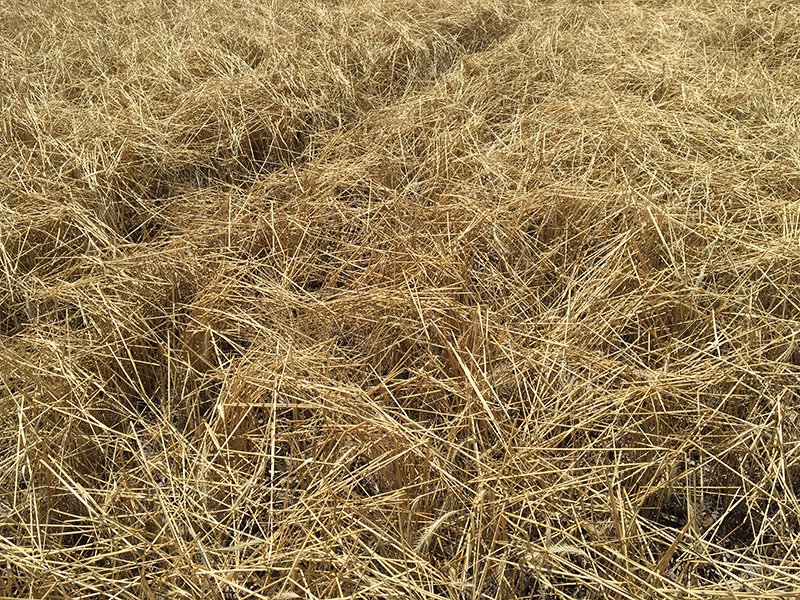
Up until recently, they’ve always used just a pure stand of rye since it did most of what was needed, but—due to signing up for this CSP enhancement—in the fall of 2017, Unruh’s added winter rape, radish, common vetch to the rye (I wasn’t involved in choosing this mix—although I’d been encouraging them to add hairy vetch to the rye for the past couple years, primarily for soil biological reasons and the knowledge that cover-crop mixes seem to benefit all species so long as they’re halfway compatible; we need more diversity—so long as we can do it on a budget). So far, as of this writing [January 2017], these broadleaf species haven’t done much, perhaps due to the late seeding of the mix (the rye looks good, however). Also, the brassicas probably don’t like the full rate of generic Callisto that was applied in the corn.
Lewis & Jason think they gain a little soybean yield from having the rye out there, although they’ve long since quit doing comparisons—rye ahead of beans is standard procedure. In very droughty 2012, they were still experimenting with rye and found that where they had rye, the soybeans made 17 bu/a, but where they didn’t have rye, they only made 12 bu/a. Since they experience moisture deficits nearly every summer in August when soybeans are ‘drinking’ the most, Unruhs figure they gain a little yield every year from having the rye out there.
Lewis says, “The rye is helping on weed control. It’s taking care of the marestail”—which have been a big problem for them in the past (their marestail have been glyphosate-resistant for ~10 years and are very tolerant of 2,4-D anymore). A study by Stanley Culpepper of Georgia showed 65 – 95% suppression of Palmer pigweeds when a thick stand of rye was rolled ahead of cotton. While Unruhs don’t specifically roll down their rye, the gauge wheels on the drill perform some of the same function. While imperfect, and their rye isn’t always “thick,” the suppression of pigweeds (including waterhemp) is undeniable—I’ve seen the difference. Jason says, “In the battle against Palmers, we need to use every tool we can.” (Their Palmers are glyphosate/ALS/triazine-resistant; their waterhemp are still killed by triazines and glyphosate, however).
Unruhs still had way too much erosion yet as of 2010 – 2012, despite having been in continuous no-till with very low soil disturbance for 15 yrs at that time. Adding cereal rye ahead of soybeans from 2012 – 2017 has eliminated the lion’s share of that remaining erosion, although they still have to be careful in other parts of their rotation—which they’ve also improved to mitigate erosion.
Lewis says, “Erosion control isn’t something where you get a check you can take to the bank right way. It’s down the road, including for future generations. But we’re now farming close to 100 acres that were abandoned at one time. So, we’re headed the right direction.” Lewis and his late father, Charlie, were always conservation-minded, so they were among the very first in their community to go to full-fledged, continuous no-till once I came along and explained how it could be done successfully.
Where once upon a time Unruhs did a lot of double-crop soybeans on wheat fields going to corn the next year, they gradually migrated to doing double-crop corn—the economics were okay, and they got a lot more mulch cover out of the dc corn than the dc soys, in addition to keeping the wheat stubble standing—which is an immense help in making it last longer. Jason says, “It doesn’t make any sense to use a stripper head and then run it all thru a combine when you harvest the dc beans.” Indeed. Lewis comments, “I’ve harvested a lot of 8 – 10 bu/a double-crop beans in my life,” and noting that with today’s weed challenges and his thin soils, double-crop soybean economics just don’t look too exciting—and there’s a lot more risk in having lots of double-crop out in the field at the same time as the full-season crops. Hailstorms, for instance.
To preserve the wheat stubble, Unruhs switched to double-crop corn on the better fields approx 5 – 6 yrs ago, although they didn’t do any in 2017 due to lower grain prices for corn, and getting hit so hard with Southern rust in the dc corn in 2016. Lewis also says, “Corn after double-crop corn lags a little [in yield, as compared to after wheat stubble with cover-crop pearl millet].” Some of this is due to the lesser amount of mulch holding moisture late in the season, but also some issues with seedling disease being much worse on some years following dc corn than cc millet—even though the corn is planted between the dc corn rows. But they’ll revisit dc corn on their creek-bottom fields if corn grain prices improve someday.
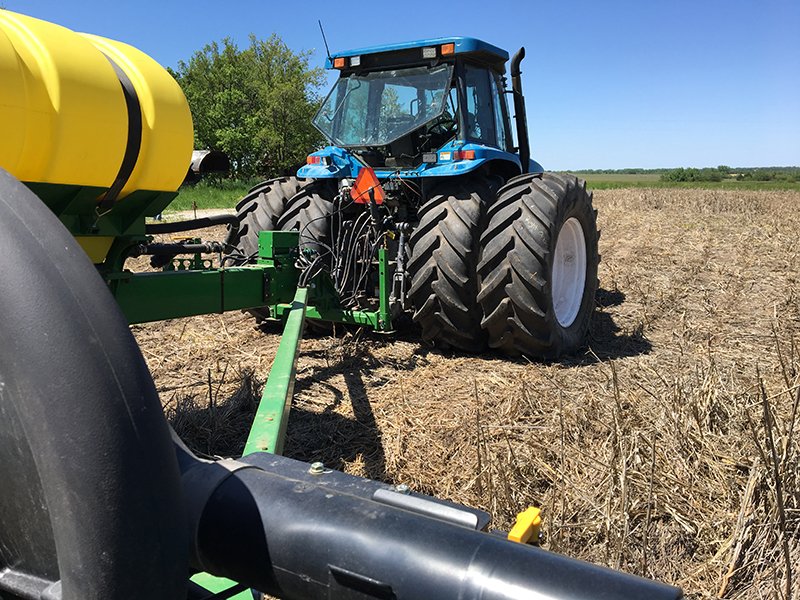
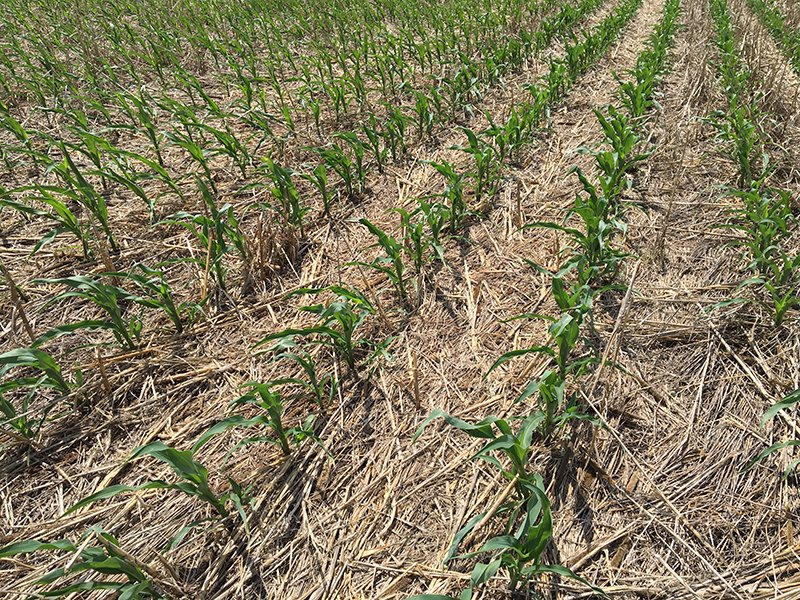
On the cover-crop pearl millet, if soil moisture allows (it doesn’t take much), they like to get it drilled soon after wheat harvest, so it gets as much growth on it as possible, Lewis explains—and his agronomist agrees 😀. If there’s no moisture after wheat harvest, they’ll drill it anytime they get moisture up until mid-August (thus far, they’ve always gotten it established—but if we ever have a very long dry stretch, we might elect to do cover-crop oats after mid-August if the opportunity presented itself). Just before seeding or before emergence, all acres of pearl millet get a burndown with a paraquat mix (they’d have to use paraquat at least twice, maybe 3x, if the wheat stubble was fallow for the rest of the summer). Their pearl millet grows until it freezes, which means it usually has headed out and may even have set seed (not much of it is viable the following year—it’s a non-issue). If they get a good stand of millet, it holds out the volunteer wheat. If they get some Palmers showing up in the millet, they spray it with dicamba, 2,4-D, and atrazine (any volunteer wheat is also taken out by the atrazine). Unless the wheat crop was meager, usually this pearl millet gets a low rate of urea + sulfur (or AMS) to help it make decent biomass. Fertilizing the millet also cuts down on how much extra fertilizer must be pushed to the corn the following year to prevent yield drag. Their pearl millet has always been a pure stand until 2017 when, again due to CSP rules, they included winter rape, buckwheat, and a very small amount of sudan (I wasn’t involved in creating this mix either—I might prefer forage radish to winter rape, for instance, and not sure I want a bunch of buckwheat going to seed).
Is letting the wheat stubble set idle for the rest of the summer ever an option? Jason says, “No, it would start moving. First the stubble, then the soil.” Jason points out that, due to shifting some fields around this last spring to even out their crop split (after doing away with stacked wheat), they had some corn planted into a single-year of wheat stubble with cover-crop sunflowers & sunn hemp (originally slated for 2d-yr wheat), and the clumps of straw and erosion there were ugly, and that it would be just as bad or worse without having had anything at all growing there over the summer (yes, the drill destroyed a bit of wheat stubble in getting the cc planted, but it also added a little bit of durable mulch, and dried the soil out so it could infiltrate more). So, they take their pearl millet very seriously.
While Unruhs routinely did second year wheat in their rotation for 20 years, they’ve now quit it completely—partly due to the poor wheat price, but also because of increasing ‘cheatgrass’ (downy brome, chess) pressure from too many cycles of a 4 year rotation with 2 years of wheat each time (when they did stacked corn, that leg of the rotation kept cheatgrass at bay when they came back around to stacked wheat—i.e., 2 years of wheat in a 5 year rotation).
The 2d-yr wheat also was high-input, since Unruhs typically needed to do a cover-crop of sunn hemp & sunflowers between the two wheat crops to dry the soil adequately, lest they have big drowned-out spots and poor wheat growth where it did survive. With seeding the cover crop, terminating it with a couple spray passes, plus the burndown ahead of the cover crop, it was much more costly versus wheat right after soybeans. And in their area, the second-year wheat often didn’t yield that much more than first year wheat after beans, so those costs cut into the bottom line. One thing this rotation did do, however, was clean up a lot of summer weed pressure, and give them more mulch cover to get thru the corn & soybean years without erosion getting too bad. But with their now-standard practice of growing thick pearl millet as a cover crop after wheat that’s going to corn, and only a single year of corn, plus the rye ahead of soybeans, they don’t need the 2d year of wheat stubble.
So, after a bit of adjusting of acres (mostly done carefully with cover crops to minimize erosion risk), Unruhs are now at around 1/3 wheat, 1/3 full-season corn, and 1/3 soybeans. Lewis says, “We would go back to stacked wheat if the price improved [in relation to corn and beans].” He adds, “Some people in the area have even less than 1/3 wheat, but we’ll keep ours at 1/3. We’ll keep doing this 3-year rotation until it develops some problem. I’m satisfied with our rotation right now and will keep doing it until something shows up and we’re forced to change.”
Seeking to do even more with cover crops, Jason embarked on a project of his own initiative in 2016 to interseed covers into established corn. He modified an old 3-point double-disc drill to get rid of the openers on top of the corn row. While the species he interseeded after corn emergence didn’t amount to much that year because of dry weather afterwards, he and I are both encouraged by it. 2017 was hectic due to wet weather and so it wasn’t repeated, but the plan is to try again in 2018—with some new ideas on species from yours truly.
Unruhs’ wheat, soybeans, and cover crops go in with a pair of JD 1590 box drills on a Houck hitch (10-inch spacing) that are outfitted with liquid fertilizer for pop-up in the seed row. Wheat gets 10-34-0, sometimes spiked with additional UAN or AmChlor Basic, plus micros. Wheat after soybeans gets urea + AMS spread as soon as possible after the combine leaves the field to maximize the chance of catching a rain in Oct or early Nov to get it moved into the soil for the crop to benefit. Additional urea is applied in March.
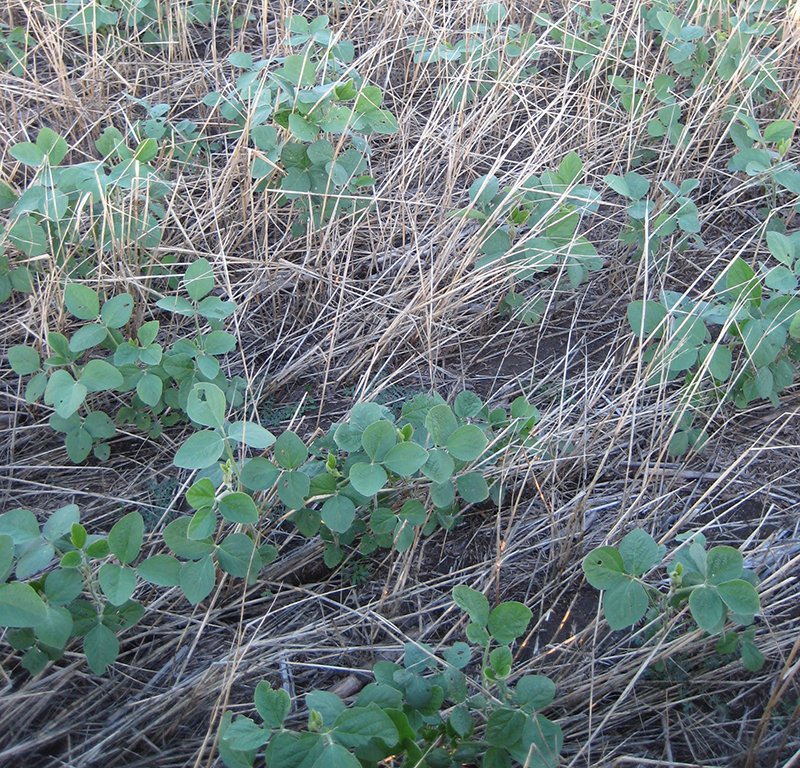
Since he began no-tilling, Lewis has tried every method under the sun for applying N for corn. They’re still experimenting, but basically about 2/3 of the N and all their sulfur goes on either immediately preplant as urea + elemental S broadcast, or by dribbling UAN + ammonium thiosul (ATS) alongside the row behind the planter’s closing wheels. The remainder of the N is side-dressed when the corn is 2- to 4-ft tall, either as UAN with drops with their Spra-Coupe, or hired as urea b’cast. P is split between pop-up and the remainder is either surface dribbled behind the planter, or b’cast dry with the urea. Micronutrients are also included in the pop-up and/or sideband, and sometimes K as well. Unruhs have seen increasing K deficiencies over the years, especially on bottomland that floods.
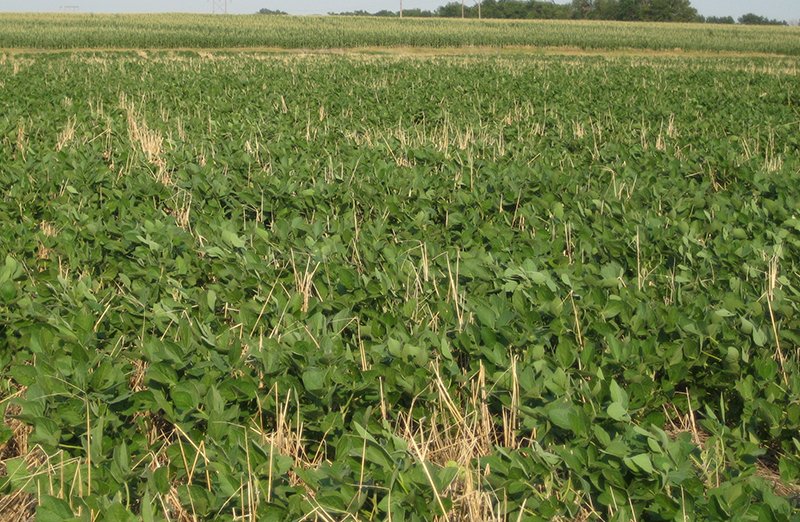
When the rye is terminated at heading, Unruh’s procedure is to next apply sulfentrazone, wait for rain to activate the chem, then drill beans. Even their LibertyLink and Xtend beans get the sulfentrazone treatment, as well as other residuals—it’s not easy keeping the Palmers out (they’ve been rogueing the escapes out of their bean fields the last few years—either themselves or hiring a crew). Because the rye has dried the soil out to depth, there’s not been any issue with catching a monsoon and making the fields unplantable due to slow drying from the rye thatch (although they did have troubles one year with loss of stand due to seedling disease where the rye was super thick and it rained so much after drilling that water ponded on many of the fields—including upland!—for far too many days over the course of a few weeks when the beans were seedlings—the worst problem was on a field that was newer to no-till however, and didn’t have as good of internal soil structure to drain the water away). Also, it doesn’t hurt that their long growing season allows them to wait till early June to drill beans if need be—there’s not any yield drag from early June-planted beans in their area over the long-term. Their long-term soybean yield average is in the low 30s, mostly due to brutal hot/dry weather in August and thin upland soils. Tillage neighbors’ beans yield considerably less, if they even consider them a viable crop—some just grow wheat and milo.
Unruhs are able to go fairly low on soybean seed drop and get consistent stands without fear of needing to interseed, partly because their JD drills are kept in good condition, use Thompson spoked closing wheels (JD cast closing wheels do way too much packing in their damp clay soils). Jason says, “The Thompson wheel doesn’t bounce as much, so it does a better job of closing.”
Their drills also use Exapta’s UniForce hydraulic down-force system to get more consistent depth and less hairpinning, while avoiding overpacking the sidewall. Although these weren’t exactly their reasons for going to the system: Lewis says, “With our terraces and uneven ground, we wanted to keep constant pressure on all the openers and have more stroke. We didn’t like having to apply so much extra pressure to make the OEM springs sorta work when the opener went through a small depression. On our old drill, we broke the frame a couple times, and the rockshafts a couple times. We hope to avoid that stress on our newer drills with UniForce’s greater stroke and more constant pressure.” (Lewis was the one who set me on the path to developing UniForce, a winding journey that evolved out of a discussion in his living room—I had long had the idea, and he was the one who convinced me it wouldn’t be that hard. Ha! And their 15-ft 1560 was the first drill we outfitted with some early prototypes of the UniForce system.)
Lewis first began no-tilling his corn in the ’90s with an archaic Allis ‘no-till’ planter from the 1960s. The stands were terrible. I strongly encouraged him to find something better, which led him to buy a still-old (but not antique) 6-row JD 7000, in ’98, on which he spent more money on attachments and upgrades than for the planter itself (some of this is described in a No-till on the Plains’ Leading Edge article in ’03). That planter served him well for many years, but as he grew more corn, he wanted a bigger planter and moved up to a new 12-row Monosem. He never could get decent stands with the Monosem despite 5 years of trying and many improvements—a lot of the problem stemmed from the gauge wheels being much too far forward in relation to the blade (excessive sidewall lifting; too many misplaced seeds from duff and bits of sidewall falling in ahead of the seed).
Out of frustration, the Monosem was replaced with a 16-row JD XP for double-crop 2016. The 16-row XP has row cleaners, Valion seed tube guards, Keetons + Mojos, and Thompson closing wheels with toe-out wedges. It uses air bag downforce. Lewis says, “The seed tube guard is pretty important. [Having the guard full width] solved the bearing problems on our [JD] 7000. And it keeps the furrow from getting too narrow.” They adjust the row cleaners so they hardly do anything—they were on the planter when they bought it, or they wouldn’t have added them (their Monosem didn’t have any), although Jason wonders if they should tickle just a little more straw out of the way. As for the Thompson wheels, Lewis says, “In our soil conditions, once we had the Keetons, then having loose soil over the seed versus compressing it is a good thing.”
Not only do the Unruhs try to grow lots of durable mulch with their pearl millet and rye covers, but they try to keep more of it with field operations. Their Monosem & DeereXP haven’t had side-band fertilizer openers like their JD 7000 did. Longtime users of a Shelbourne for wheat, they also got the benefit for many years of relatively tall, intact corn stalks harvested with a worn-out Gleaner head (and Lewis always drove as fast as he could, simply for efficiency). Unfortunately, they updated to a newer model 8-row Gleaner head that’s far more aggressive.
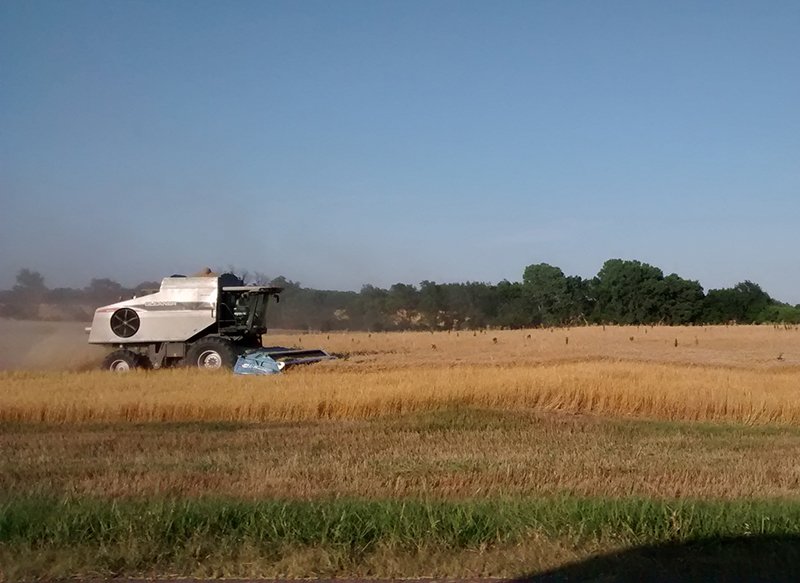
As for the changes they’ve seen with no-till, Unruh’s used to have completely separate rotations for slivers of bottomland on fields that were primarily hills. That gradually went away the longer they were in no-till, partly because the crops that they became able to grow on the hills were the same as bottomland. Lewis says, “Years ago, we wouldn’t have planted corn on the hills.” (It was milo, which they’ve long since discontinued—even though upland corn yields in their area might seem pathetic to many readers, milo doesn’t do any better on average—no-tillers in their locale have learned to grow corn in the hills, and milo acreage has declined markedly.)
Yields of all their crops, including wheat, have improved dramatically along with their soils and better practices. Lewis says that with no-till, “The yields across the field are more uniform.” So, their worst soils have improved the most.
Lewis also likes the efficiency of no-till: “We never farmed over a terrace until no-till. Our efficiency has increased a lot now that we’re able to wobble over terraces with the planter and drill, and for spraying too.” They have scads of terraces, so this is a big deal for them. Indeed, they had a big 4WD tractor and wide tillage equipment to get it all done before they went to no-till. Continual improvements while steady at the helm, the Unruh’s exemplify the best practices for no-till and true sustainability.
